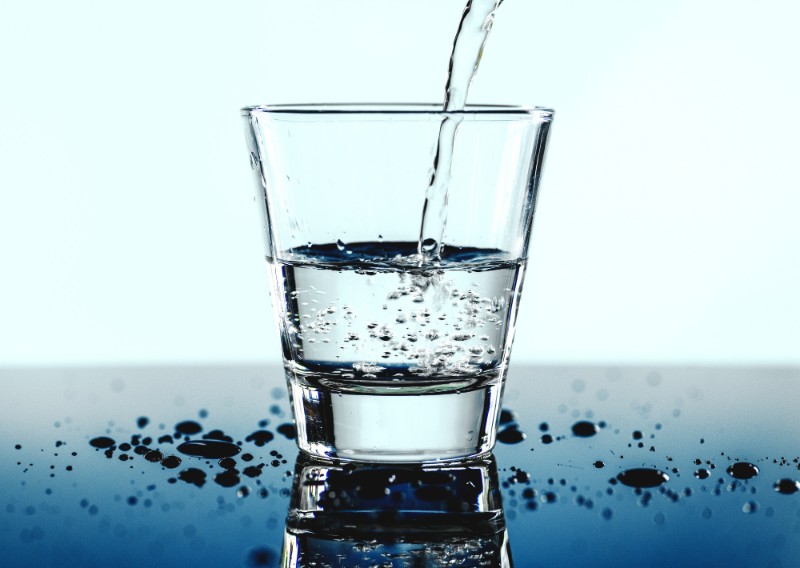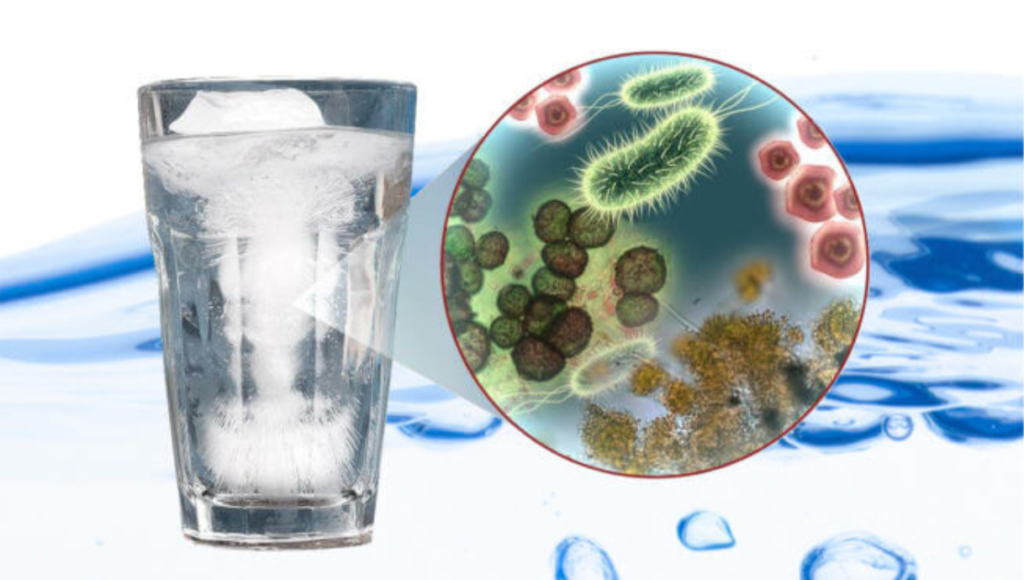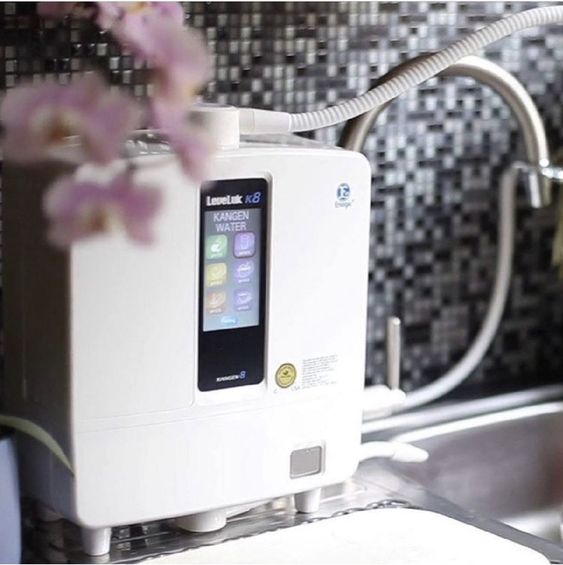You Are What You Drink: How to Avoid the Contaminants in Water
If you were asked to choose what is most important to your health – Sleep, Food, or Water… what would you choose?
If you chose water, you are correct!
The human body is comprised of nearly 70% water, so it’s not much of a stretch to say that “the basis of vitality and long life is water.”
If you want to feel good and be at your optimal health level, you must drink water on a daily basis.
But just exactly what kind of water are you made of?
Well.. that depends on the water you are drinking.
Not all water is created equal – let’s take a look at why.

A Look At The Contaminants in Water
Tap Water / Ground Water
Tap water is a healthier option than soft drinks. But according to the Environmental Working Group, there have been 315 pollutants found in America’s tap water since 2004, and over half of these pollutants are completely unregulated and can legally exist in any amount. Yuck.

Sometimes you can see, smell or taste the contaminants in water – but most of the time your water looks, smells, and tastes fine. But is it? The Water Quality Association says:
“Not necessarily…. Microbial and organic contaminants cannot always be detected by human senses. You might go years before realizing a problem exists. Many folks never become suspicious until people in the community start to get sick. Water near agricultural areas may contain harmful organic material from pesticide or fertilizer application. Chemicals from pesticides and fertilizers in water may increase cancer risk and reproductive problems, and can impair eye, liver, kidney, and other body functions. Similar problems can result from exposure to water near industrial plants.” [1]

Do you know what’s in your tap water? Here is a list of the top common pollutants in tap water. [1]

- Aluminum
- Ammonia
- Arsenic
- Barium
- Cadmium
- Chloramine
- Chlorine
- Chromium
- Copper
- Fluoride
- Bacteria & Viruses
- Lead
- Nitrates/Nitrites
- Mercury
- Perchlorate
- Radium
- Selenium
- Silver
- Uranium
At the current levels of contaminates in water, the public is starting to question the quality of tap water and wonders if it is safe enough to drink. This is leading to an increase in filtered and bottled water and contributing to the huge amount of plastic waste.
Bottled Water
Bottled water is not necessarily healthier than tap water and yet it costs so much more!
Often bottled water is filtered using reverse osmosis, and frequently the only difference between tap and bottled water is the added inorganic minerals in bottled water (which have no proven health benefits).
A four-year study by the Natural Resources Defense Council shows that 1/3 of the bottled water tested contains levels of contamination which exceed allowable limits. Make’s you wonder why you are paying for bottled water, doesn’t it!

In another study, 250 bottles of water were randomly purchased. These researchers tested in over nine countries, including the USA, with the same results—plastics particulates were found in 93% of the samples, and these were from the major water companies—Nestle, San Pellegrino, Dasani, Evian, Aqua, and Aquafina. When confronted, all brands tested told the BBC that their bottled water products were “produced to the highest standards”.
Note: in the plastic particulates study above, only plastic pieces that were larger than 100 microns were counted, meaning that there is actually more plastic in the water than expected. 100 microns is about the size of a human hair, which when you think about it, is a pretty large chunk of plastic to be consuming with our water. There were many more particles found that were under the size of 100 microns (down to 6.5 microns even), they just weren’t counted in this particular study. [3]
Because we are conditioned to believe that bottled water is healthier than tap water, we often overlook the costs and extremely high markups associated with buying bottled water. (You can expect to be paying at least 4,000% markups on bottled water, as compared to the manufacturing costs involved.) [4] [5]
Take a look at this chart below and you can see what your annual water costs might be based on the different bottled water options available. Plus there’s a 15 year cost analysis included which I think shows how much these minor expenses can really add up over time.
US Environmental Protection Agency (EPA) Quote:
“We generally pay much less for our tap water than we do for most other goods and services…On average, tap water costs are slightly more than $2 per 1,000 gallons…Each of us, on average, uses over 100 gallons of water per day for everything from drinking and bathing to watering our gardens…This equates to an average annual water bill of about $300 per household“ [3]

NOTE: Figures were calculated based on a family of four, using a recommended daily water consumption formula of ½ the bodyweight of each individual in ounces of water: Father – 190 lbs, Mother – 160 lbs, 13-year-old son – 100 lbs, 10-year-old daughter – 75 lbs. Weights based on National Center for Health Statistics for average weights of individuals living in the US. This family should consume 262.5 ounces, or 2.05 gallons, of water each day. The calculations above have been figured using 2 gallons of daily consumption. [3]
The 15-year KangenWater information is based on the ionizer model SD501, with a retail price of $3,980.00. It also includes the cost of a high-grade filter, replaced annually; 2 cleaning cartridges, used annually; 5 deep cleaning services – completed once every 3 years, and the average cost of tap water, as indicated by the US EPA, at the rate of $.002 per gallon. [3]
I’ve certainly bought and drank my fair share of bottled water, and I can’t believe how much I’ve actually spent on bottled water over the years if I really think about it.
But to be fair, I knew my tap water was “bad”, and I simply thought, like so many others do, that bottled water was “good”. And now, I know better.
We have known for some time now that bottled water wasn’t a long-term solution to avoid or replace our tap and drinking water. And now, thanks to these top-of-the-line filtration systems and water ionizer machines, we have a sustainable solution.
Now that we know better… we can start to do better. For ourselves, for our loved ones, for our pets, and for the planet.

And one more thing about all those plastic water bottles – the environmental impact caused by the production and disposal of plastic bottles is incredibly harmful to our ecosystem.
Did you know 8,000,000 tons of plastic is dumped in the ocean every year? That is equivalent to 5 grocery bags per every foot of coastline around the globe! [6]

Plus, with all that plastic floating in the ocean, now our oceans are getting filled up with all those tiny plastic particulates as well… and causing disruption to the natural eco-system.
In fact, it is estimated that by 2050, our oceans will contain more plastic than fish.
The truth is, bottled water is simply not a sustainable choice, and we have got to do better.
Reverse Osmosis Water
Reverse osmosis is a water purification process that uses a partially permeable membrane to remove ions, molecules and larger particles from drinking water. [2]
Reverse Osmosis may be effective in areas that do not receive municipally treated water and it is commonly used in bottled water facilities.
The problem with this process is that dangerous chemicals like pesticides, herbicides, and chlorine are molecularly smaller than water and can pass freely through the reverse osmosis filter.
And when it comes to the larger molecules, while they can do a great job at removing the larger sedimentary pollutants listed in the tap water section above, reverse osmosis systems also remove the good with the bad.
Iron, calcium, and magnesium are a few of the beneficial minerals that may be removed by the reverse osmosis purification process, depending on the system. These minerals not only provide the water with a good taste, they also serve a vital function in the body’s system.
When stripped of all of these good minerals, water can become unhealthy. Purified water is often referred to as “dead water” because of this.
Sometimes, thru a process called re-mineralization, synthetic chemical versions of these beneficial minerals are even added back into the purified water.
Unfortunately, other than enhancing the flavor of the water, these synthetic minerals have little to no proven health benefits and are less likely to be processed by your body.
Often the water produced from a RO system can even be more acidic than bottled water and is something to consider when drinking it directly from the faucet.
To combat this, some RO systems even give you the option of adding in even more inorganic chemicals (such as baking soda and Epsom salts) to your purified water at the end in order raise the pH to an alkaline state. (Please note: this chemically created alkaline water has little to no proven health benefits.)
To make matters even worse, 2-3 gallons of water are wasted for every single gallon of purified water produced through the reverse osmosis process.
Drinking Water Filtration Systems and Whole-Home Filtration Systems
There are many different types of filtration systems – some purify the water using the process of Reverse Osmosis (discussed above), and some are filtration systems that use different filters (bone char, activated carbon, charcoal, solid carbon block, etc.) to remove chemicals, bacteria and impurities, and others simply filter out sediment changing your “hard-water” into “soft-water”.

Multipure’s carbon block drinking-water and whole-home filtration systems are NSF certified for removal of up to 90 different contaminants. They can be used in conjunction with water ionizer machines, in fact they are the perfect duo, and I that’s why I never recommend one without the other.
If you are interested in learning more about the different types of filtration systems available from Multipure, please visit my Multipure Webpage.
And there is even a mineral ion shower spa system which filters, ionizes, and re-mineralizes the water in your bath and shower. If you are interested in learning more about these ionizer products, please send me a message or book your discovery call today!
Ionized Alkaline Water

Water ionizer machines, like the one pictured, offer you a way to reduce your own plastic waste, and to do your part to contribute to environmental sustainability and the health of the planet.
These machines allow you to filter and use the tap water straight from your faucet, and transform it into what many call the most incredible drinking water on the planet! The ionized alkaline water is hydrogen rich, and packed full of antioxidants.
Electrolyzed-reduced water is ionized alkaline water that has been filtered to remove impurities, and gone thru an ELECTRICAL process to increase its pH balance. This water’s pH level has been raised above 7.0 by the process of electrolysis.
The electrolysis process produces ionized, alkaline, hydrogen-rich water by using electric currents to change the natural molecular structure of the water, without the addition of chemicals or synthetic compounds. Hydrogen-rich water has some pretty incredible health benefits and is one of the main reasons the demand for this ionized alkaline water is constantly increasing!
Just a reminder – ionizer machines are designed specifically as water ionizers and not as filtration systems. While the ionizers don’t filter out all of these impurities from the tap water with their standard filters, they do filter out the chlorine, and can be used with several different pre-filtration systems which will filter many other pollutants out before running your tap water through your ionizer machine.
As mentioned above, pre-filters are strongly encouraged for use with any water ionizer machines, and Multipure is the industry leader, and your “go to” for all NSF certified filter systems in the US and Canada. For more information, please visit my Multipure webpage.
Learn how using a Pre-Filter can extend the life of your water ionizer machine.
Resources: -Click to Expand-
If you have questions, would like to learn more about these industry-leading water ionizer machines, filtration systems, or if you'd like to learn more about creating your own income stream with this amazing business model, then message me, or Schedule Your FREE Discovery Call Now!




